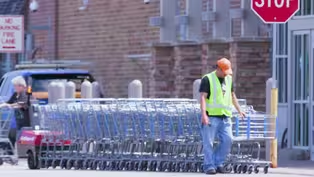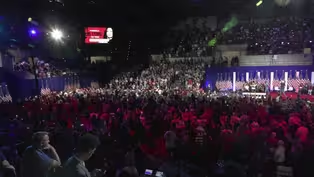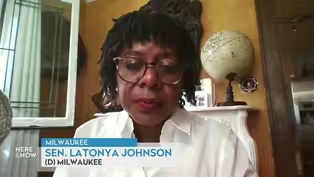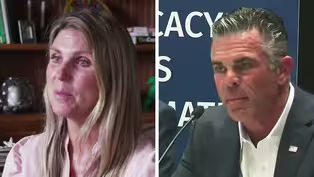Here and Now
Laura Dresser on the State of Working in Wisconsin in 2024
Clip: Season 2300 Episode 2309 | 5m 20sVideo has Closed Captions
Laura Dresser on job numbers, wage growth and gender pay gaps.
UW-Madison labor economist and High Road Strategy Center associate director Laura Dresser discusses the group's State of Working Wisconsin 2024 report on job numbers, wage growth and gender pay gaps.
Problems playing video? | Closed Captioning Feedback
Problems playing video? | Closed Captioning Feedback
Here and Now is a local public television program presented by PBS Wisconsin
Here and Now
Laura Dresser on the State of Working in Wisconsin in 2024
Clip: Season 2300 Episode 2309 | 5m 20sVideo has Closed Captions
UW-Madison labor economist and High Road Strategy Center associate director Laura Dresser discusses the group's State of Working Wisconsin 2024 report on job numbers, wage growth and gender pay gaps.
Problems playing video? | Closed Captioning Feedback
How to Watch Here and Now
Here and Now is available to stream on pbs.org and the free PBS App, available on iPhone, Apple TV, Android TV, Android smartphones, Amazon Fire TV, Amazon Fire Tablet, Roku, Samsung Smart TV, and Vizio.
Providing Support for PBS.org
Learn Moreabout PBS online sponsorshipattitudes about the economy will likely persist.
For "Here& Now".
I'm Nathan Denzin in Madison.
>> From the cost of things to wages and jobs ahead of Labor Day, we check in on the annual State of working Wisconsin report with UW-Madison economist and associate director of its High Road Strategy Center, Laura Dresser, and thanks a lot for being here.
Thanks for having me.
>> So in a nutshell, what is the overall state of working Wisconsin?
this year, I think, is a continuation from in the recovery from the pandemic shutdowns.
We know we've been seeing high job production that's still true.
25,000 new jobs across the last year in the state of Wisconsin, highest ever number of jobs.
We have low unemployment rates and we had a strong wage increase at the median last year.
>> So what's responsible for this growth in jobs as you describe?
ticking along.
Well, I know there's a lot of discussion about whether people think the economy is good, but from the perspective of workers, where a high demand in the labor market means that people can get into the labor market and it means that people when they hold jobs, they can ask more of those jobs.
They have a little better position, bargaining position.
That's all true in this labor market.
And it's a continuation of what we've seen coming out of that.
The severe lockdown, the shutdowns.
But is there any sense that it is slowing down?
>> You know, I think there's you know obviously that last month's National Jobs data was softer than expected.
There was a recent revision to the total national numbers on jobs.
So the rate, the pace of job growth is slowing.
We're still adding jobs and the unemployment rates have been pretty steady and very low, like pretty steady below 3% in the state and or around 3%.
That's really low in employment.
And that and so that bargaining position for workers like there are there are clouds on the horizon.
A lot of concern about what comes next.
And I think that's what everybody is looking at, future job production and that unemployment rate to change.
But for now like very solid.
We'll take solid year.
We'll take now.
>> So again what does that do for wages.
What are the kind of specifics on that.
>> Yeah.
So probably everybody remembers 2022 was a year of really high inflation.
That means that wage increases in that year did not keep up with the cost of living.
So we'd had steady wage growth.
And then a step back in last year's report this year, we had the strongest one year median wage growth that we've seen.
And that's all inflation adjusted.
So the one we wages increase at the median by $0.97 an hour or almost a dollar an hour.
That's the strongest we've ever seen.
It ties with a 2019.
But but that's really strong step forward in wages.
And we're very near the 2021 peak in wages.
So strong wage growth because workers are bargaining for more.
Employers are needing to pay more to find workers in these tight labor markets.
our minimum wage sits at $7.25 an hour.
>> Yeah, the state of Wisconsin is, you know, the labor market infrastructure, the kind of wage standards we set are being really left behind by neighboring states.
It's above $10 an hour in both Michigan and Minnesota, $13 an hour for the minimum in Illinois.
Wisconsin is just out of touch in terms of setting the standard in our labor market for the base.
>> You also describe in your report that there is a gender pay gap that persists.
>> Yeah, it's you know, we've seen some shrinking in inequality.
One of one of the exciting things about this recent period is lower wage workers have made bigger gains.
And we know that even over the last 40 years, women have made gains relative to men.
There's still a substantial pay gap.
And it's especially extreme for black women, for Hispanic women whose workers are whose wages are 25 and 33% below white men's wages.
>> So you your report also suggests that there are ways to make these gains durable, as you say.
How in your mind do you do that?
already mentioned is, is the minimum wage raising the minimum wage and trying to get the kind of floor under the labor market up more in touch with neighboring states, up more in touch with the cost of living.
Living would really matter for workers.
I think restoring rights to collective collective action, collective bargaining, restoring union rights in this state really matters for workers ability to, you know, pursue unions and to raise wages.
And then I think the other thing we see in this state, we used to have a very strong relative advantage in women's work.
Women were much more likely to work in Wisconsin than in the rest of the nation.
And that is shrinking our relative advantage in women's work.
And so I think really attending to the question of our early care and education infrastructure, investing in that infrastructure, both so that the workers who are largely women who work in it, can earn decent wages and so that families who all rely on it, but especially moms who carry the
Economic Indicators, Vibes and the 2024 Vote in Wisconsin
Video has Closed Captions
Clip: S2300 Ep2309 | 5m 30s | Jobs and wages are up but a bout of high inflation may prove politically pivotal in 2024. (5m 30s)
Here & Now opening for August 30, 2024
Video has Closed Captions
Clip: S2300 Ep2309 | 1m 20s | The introduction to the August 30, 2024 episode of Here & Now. (1m 20s)
State Sen. LaTonya Johnson on Conditions at Lincoln Hills
Video has Closed Captions
Clip: S2300 Ep2309 | 5m 41s | LaTonya Johnson on Lincoln Hills School and calls to loosen rules on restraining inmates. (5m 41s)
Trump Makes Familiar, Unexpected Promises at La Crosse Rally
Video has Closed Captions
Clip: S2300 Ep2309 | 3m 47s | Donald Trump's town hall in La Crosse turned to focus on reproductive health care. (3m 47s)
Lyerly, Wied Vie for Wisconsin's 8th Congressional in 2024
Video has Closed Captions
Clip: S2300 Ep2309 | 4m 18s | Dr. Kristin Lyerly, Tony Wied are running for Wisconsin's 8th Congressional District. (4m 18s)
Providing Support for PBS.org
Learn Moreabout PBS online sponsorship
- News and Public Affairs

Top journalists deliver compelling original analysis of the hour's headlines.

- News and Public Affairs

FRONTLINE is investigative journalism that questions, explains and changes our world.












Support for PBS provided by:
Here and Now is a local public television program presented by PBS Wisconsin




